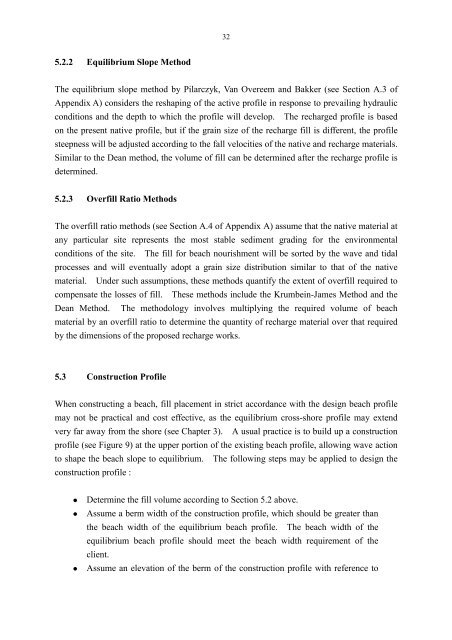PORT WORKS DESIGN MANUAL PART 5 Guide to Design of ...
PORT WORKS DESIGN MANUAL PART 5 Guide to Design of ...
PORT WORKS DESIGN MANUAL PART 5 Guide to Design of ...
You also want an ePaper? Increase the reach of your titles
YUMPU automatically turns print PDFs into web optimized ePapers that Google loves.
32<br />
5.2.2 Equilibrium Slope Method<br />
The equilibrium slope method by Pilarczyk, Van Overeem and Bakker (see Section A.3 <strong>of</strong><br />
Appendix A) considers the reshaping <strong>of</strong> the active pr<strong>of</strong>ile in response <strong>to</strong> prevailing hydraulic<br />
conditions and the depth <strong>to</strong> which the pr<strong>of</strong>ile will develop. The recharged pr<strong>of</strong>ile is based<br />
on the present native pr<strong>of</strong>ile, but if the grain size <strong>of</strong> the recharge fill is different, the pr<strong>of</strong>ile<br />
steepness will be adjusted according <strong>to</strong> the fall velocities <strong>of</strong> the native and recharge materials.<br />
Similar <strong>to</strong> the Dean method, the volume <strong>of</strong> fill can be determined after the recharge pr<strong>of</strong>ile is<br />
determined.<br />
5.2.3 Overfill Ratio Methods<br />
The overfill ratio methods (see Section A.4 <strong>of</strong> Appendix A) assume that the native material at<br />
any particular site represents the most stable sediment grading for the environmental<br />
conditions <strong>of</strong> the site. The fill for beach nourishment will be sorted by the wave and tidal<br />
processes and will eventually adopt a grain size distribution similar <strong>to</strong> that <strong>of</strong> the native<br />
material. Under such assumptions, these methods quantify the extent <strong>of</strong> overfill required <strong>to</strong><br />
compensate the losses <strong>of</strong> fill. These methods include the Krumbein-James Method and the<br />
Dean Method. The methodology involves multiplying the required volume <strong>of</strong> beach<br />
material by an overfill ratio <strong>to</strong> determine the quantity <strong>of</strong> recharge material over that required<br />
by the dimensions <strong>of</strong> the proposed recharge works.<br />
5.3 Construction Pr<strong>of</strong>ile<br />
When constructing a beach, fill placement in strict accordance with the design beach pr<strong>of</strong>ile<br />
may not be practical and cost effective, as the equilibrium cross-shore pr<strong>of</strong>ile may extend<br />
very far away from the shore (see Chapter 3). A usual practice is <strong>to</strong> build up a construction<br />
pr<strong>of</strong>ile (see Figure 9) at the upper portion <strong>of</strong> the existing beach pr<strong>of</strong>ile, allowing wave action<br />
<strong>to</strong> shape the beach slope <strong>to</strong> equilibrium. The following steps may be applied <strong>to</strong> design the<br />
construction pr<strong>of</strong>ile :<br />
• Determine the fill volume according <strong>to</strong> Section 5.2 above.<br />
• Assume a berm width <strong>of</strong> the construction pr<strong>of</strong>ile, which should be greater than<br />
the beach width <strong>of</strong> the equilibrium beach pr<strong>of</strong>ile. The beach width <strong>of</strong> the<br />
equilibrium beach pr<strong>of</strong>ile should meet the beach width requirement <strong>of</strong> the<br />
client.<br />
• Assume an elevation <strong>of</strong> the berm <strong>of</strong> the construction pr<strong>of</strong>ile with reference <strong>to</strong>

















